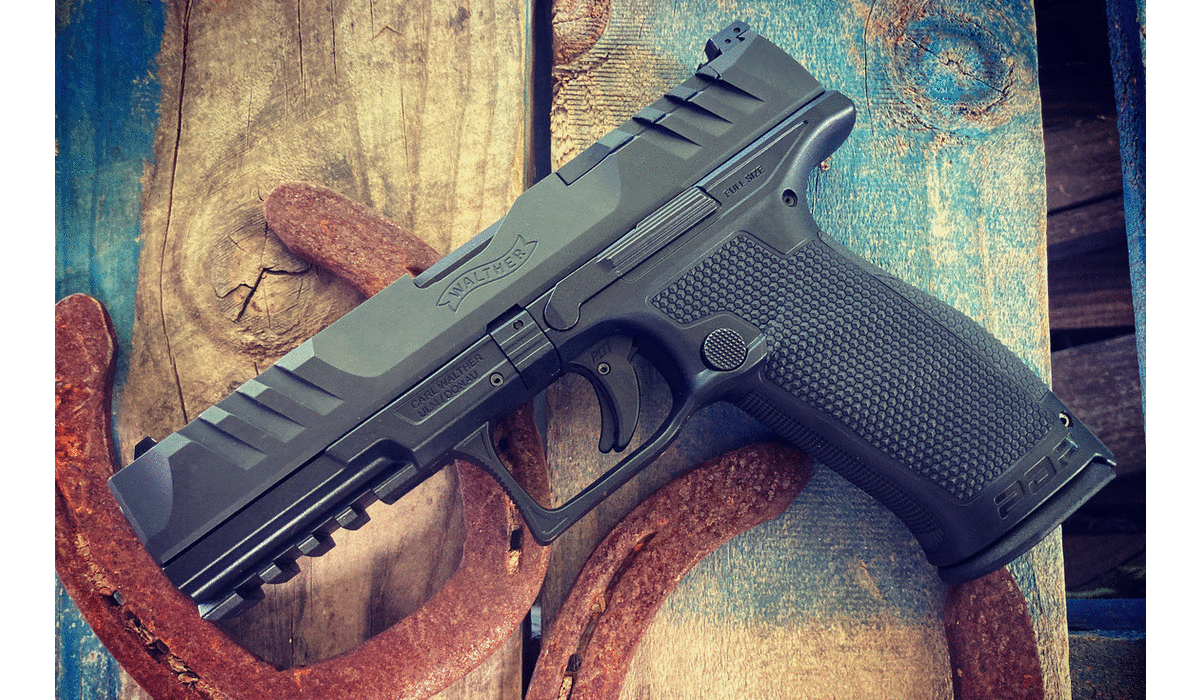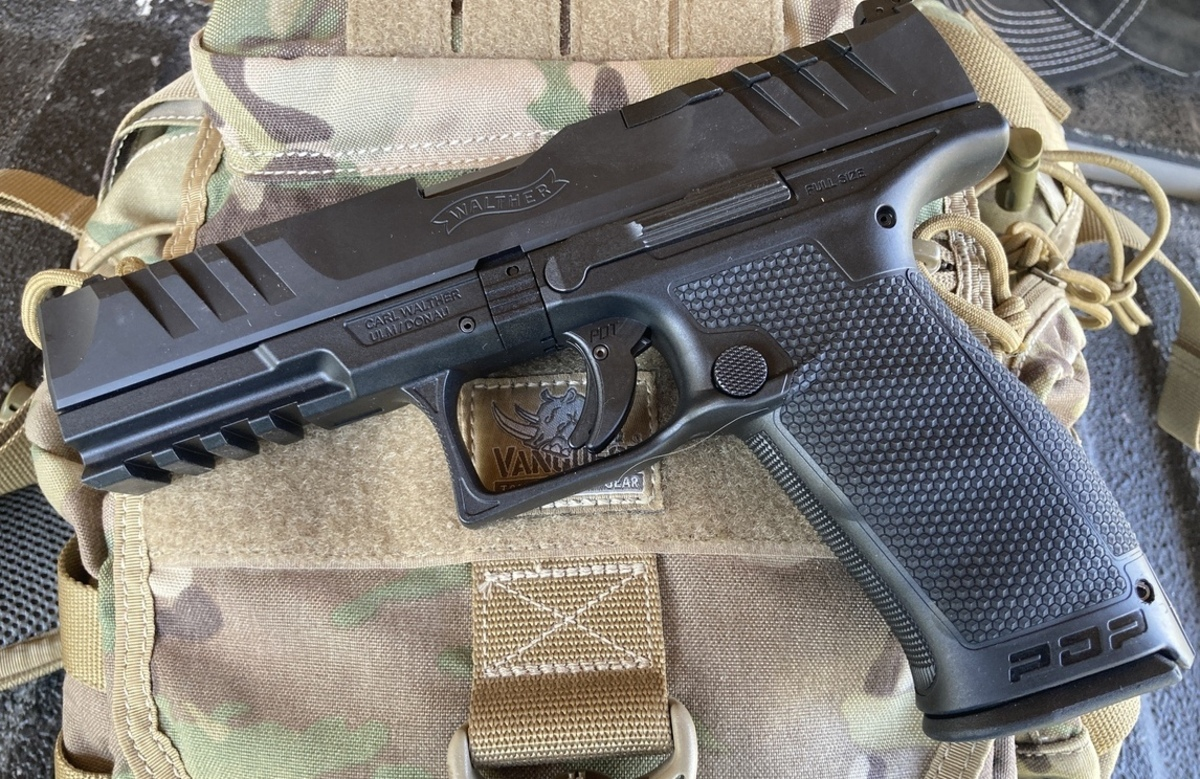Walther’s New PDP 9mm: All It’s Cracked Up to Be?
Eve Flanigan 06.16.21

A while back we shared the news that Walther had released a new series of 9mm striker-fired handguns called the Performance Duty Pistol (PDP). So far, the PDP model encompasses two “frame” (really, two grip) sizes, which hold 15 or 18 rounds, respectively, and three barrel lengths: 4″, 4.5″, and 5″. The 4″ and 5″ slides can be ordered on either the full size frame with its 18-round magazine or the compact with a 15-round magazine.
As a sucker for healthy magazine capacity and a low bore axis, among other factors, I bought my own full-size PDP with a 4.5″ barrel. This review covers the basic features of the PDP as well as the joys and oddities I’ve experienced so far as it’s being integrated into my stable of handguns used for security duty, range instruction, and general practice.
Features
Grip – As is the market standard for striker-fired pistols, the PDP is chambered in 9mm Luger and has a polymer lower. Its grip features three sizes of interchangeable backstraps. The lower grip, in the fashion of some other Walther pistols and the H&K VP series, has a rather marked hump on the lower half when the larger two backstraps are in place.
Despite this, the distance from the web of the hand to the trigger readily accommodates my not-terribly-long fingers. The backstrap-to-trigger length is very similar to Gen 4/5 Glocks; a shade longer than on my Canik TP9 pistols. Long story short, it’ll fit most adult hands with some easily changed-out backstraps.
The grip’s unusual texture is also shared with some other of the company’s pistols. Its surface is covered in a rubbery composite material, molded in the pattern of tiny cones (or are they pyramids? I don’t know, but they’re really small). The pointy ends engage with the hand making for a very secure, but not abrasive grip texture. It’s a great compromise for people who prefer a grippy gun, though I would expect it to be a little “sticky” where a covering garment is concerned if I were to wear it concealed.
Optics-Ready – The PDP was conceived as a red dot-bearing firearm. Its slide is milled to accept a red dot of any of the four most common “footprints.” This is accomplished by a mounting plate. New owners get a coupon for one free mounting plate when they mail in a postcard showing their system of choice.
Walther didn’t stop with just milling the slide. The PDP’s grip is shaped such that it invites pinky pressure. This invites a slight downward cant, which the company claims naturally positions the dot in the operator’s field of view. If I think “oh wow, I’m applying pinky pressure” while gripping the gun, it is a palpable difference, but I’ve not tested it with a red dot nor does this feature interfere with simply using the iron sights.
Performance Duty Trigger – Walther is known for great handgun triggers, and this curved-face, safety block-equipped new one only furthers that reputation. This is a really nice trigger that’s a joy to operate. The initial take-up is longish and typical of the polymer/striker class, but the break is smoother than most and the reset length and palpability rival that of a fine 1911 match-grade trigger. While its profile is decidedly old school, the PDT operates to the highest modern standard for a striker gun.
Superterrain Serrations – Apparently not being one to shun cutesy names, Walther struck a bold and somewhat different chord with the PDP’s slide serrations. They’re located both fore and aft of the ejection port, a good feature for a red dot-bearing pistol, and they also stick up ever so slightly beyond the squarish surface of the slide proper making for an aggressive texture. Here, again, may be concern for catching on clothes if this gun is worn concealed, though I’ve yet to see any complaints about that.
Sights – Shunning the latest trend of plain black rear irons, Walther went with a traditional three-dot system. The rear blade is adjustable once its set screw is loosened. Having spent lots of time behind both sight types, I’ve developed a personal preference for the old three-dot design. These are especially nice as there is little daylight available on either side of the front sight when it’s properly aligned, making accuracy fairly easy. I’m disappointed that Walther hasn’t published, to my knowledge, resources for night sight and aftermarket options as they do with holsters.
Easy-Access Controls – Oh, how I love the magazine and slide release mechanisms on this gun. It’s the only full-size in my safe that allows my thumb to drop the magazine (and they do drop without help) without dislodging my firing hand grip in the slightest. There is subtle molding around the lower half of the magazine release to prevent unintentional releases. The mag release can be switched over for left-thumb operation as well. Likewise, the slide lock on the PDP is an extended one and exists on both sides. It makes handling the gun a breeze.
Easy Takedown – Keeping with the modern standard, field stripping the PDP is fast and simple. Kudos to Walther for not over-engineering here.
Accessorizing the PDP
Each PDP ships with two magazines. The 15-round magazines for the PDP are interchangeable with those of Walther’s now-discontinued PPQ line. Unfortunately, there are no compatible matches for the 18-rounders, and I find myself out of luck every week when I go looking for them online or asking my local dealer. For this reason, my use for the full-size PDP is limited to personal/teaching, but not duty tasks, where a third magazine is a necessity. That’s been the case for two months now, and it’s quite disappointing, especially as Walther has gone to some effort to market the full-size PDP as a duty gun.
Concealment holsters for both the full and compact PDPs are already easy to find. OWB holsters for the full size one are a bit more challenging to locate. Dara Holsters is, so far, the only source I’ve found. There are no companies that I can find making a Level 2 or 3 holster for duty carry of the full-size PDP. Again, despite a strong law enforcement marketing angle, and I was dismayed to see that the PDP’s boxy slide doesn’t fit into a Blackhawk Omnivore light-bearing Level 2 holster which is touted as a holster that holds pretty much any gun with a rail. I haven’t tried it on the regular Omnivore.
Would I Buy it Again?
The jury is out. A PDP is not cheap. While the crazy $800 price tags are now a thing of the past, the guns are consistently selling in the $600-650 range, close to their MSRP of $649 for any size. I’m going to hang onto this gun in hopes that holster and magazine selection improves soon, and I darn sure hope Walther doesn’t discontinue this perfectly good line as they did with their PPQ.
This is an industrial-looking gun with a lot of visual bulk. Those who buy for looks might want to pass, but pretty is as pretty does, and this gun is a delight to handle and shoot. Had I known that magazines and holsters would be so scarce, I might have waited on this purchase, but I have it now, and love shooting it, so for now, it’ll stay.
I haven’t provided specs here, aside from the barrel lengths mentioned above. If online commentary is any indication, most buyers are choosing from the compact models available rather than the one I have in hand, so I don’t want to mislead anyone on this easily-confused data. For whatever reason, Walther chose to do the same.





